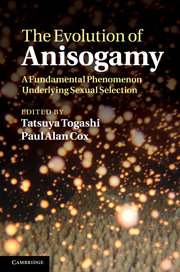Crossref Citations
This Book has been
cited by the following publications. This list is generated based on data provided by Crossref.
Lehtonen, Jussi
and
Parker, Geoff A.
2014.
Gamete competition, gamete limitation, and the evolution of the two sexes.
MHR: Basic science of reproductive medicine,
Vol. 20,
Issue. 12,
p.
1161.
Lehtonen, Jussi
2015.
Models of fertilization kinetics.
Royal Society Open Science,
Vol. 2,
Issue. 9,
p.
150175.
Bunning, Harriet
Rapkin, James
Belcher, Laurence
Archer, C. Ruth
Jensen, Kim
and
Hunt, John
2015.
Protein and carbohydrate intake influence sperm number and fertility in male cockroaches, but not sperm viability.
Proceedings of the Royal Society B: Biological Sciences,
Vol. 282,
Issue. 1802,
p.
20142144.
Lehtonen, Jussi
Kokko, Hanna
and
Parker, Geoff A.
2016.
What do isogamous organisms teach us about sex and the two sexes?.
Philosophical Transactions of the Royal Society B: Biological Sciences,
Vol. 371,
Issue. 1706,
p.
20150532.
Beekman, Madeleine
Nieuwenhuis, Bart
Ortiz-Barrientos, Daniel
and
Evans, Jonathan P.
2016.
Sexual selection in hermaphrodites, sperm and broadcast spawners, plants and fungi.
Philosophical Transactions of the Royal Society B: Biological Sciences,
Vol. 371,
Issue. 1706,
p.
20150541.
Lehtonen, Jussi
Parker, Geoff A.
and
Schärer, Lukas
2016.
Why anisogamy drives ancestral sex roles.
Evolution,
Vol. 70,
Issue. 5,
p.
1129.
Aslan, Umit
Dabholkar, Sugat
and
Wilensky, Uri
2017.
Autonomous Agents and Multiagent Systems.
Vol. 10642,
Issue. ,
p.
51.
Mizumoto, Nobuaki
Abe, Masato S.
and
Dobata, Shigeto
2017.
Optimizing mating encounters by sexually dimorphic movements.
Journal of The Royal Society Interface,
Vol. 14,
Issue. 130,
p.
20170086.
Nieuwenhuis, Bart PS
2017.
Encyclopedia of Life Sciences.
p.
1.
Constable, George W. A.
and
Kokko, Hanna
2018.
The rate of facultative sex governs the number of expected mating types in isogamous species.
Nature Ecology & Evolution,
Vol. 2,
Issue. 7,
p.
1168.
Samani, Pedram
2018.
Digest: Evolution of sperm size and number in external fertilizers*.
Evolution,
Vol. 72,
Issue. 1,
p.
211.
da Silva, Jack
2018.
The evolution of sexes: A specific test of the disruptive selection theory.
Ecology and Evolution,
Vol. 8,
Issue. 1,
p.
207.
Aslan, Umit
Dabholkar, Sugat
and
Wilensky, Uri
2018.
Multi-Agent Based Simulation XVIII.
Vol. 10798,
Issue. ,
p.
47.
Jaffe, Klaus
2018.
Synergy from reproductive division of labor and genetic complexity drive the evolution of sex.
Journal of Biological Physics,
Vol. 44,
Issue. 3,
p.
317.
Ghiselli, Fabrizio
Breton, Sophie
and
Milani, Liliana
2018.
Mitochondrial activity in gametes and uniparental inheritance: a comment on ‘What can we infer about the origin of sex in early eukaryotes?’.
Philosophical Transactions of the Royal Society B: Biological Sciences,
Vol. 373,
Issue. 1741,
p.
20170147.
Geng, Sa
Miyagi, Ayano
and
Umen, James G.
2018.
Evolutionary divergence of the sex-determining gene MID uncoupled from the transition to anisogamy in volvocine algae.
Development,
Vol. 145,
Issue. 7,
MIZUMOTO, NOBUAKI
2019.
Sexually differential movements and optimization of mating encounters.
Japanese Journal of Animal Psychology,
Vol. 69,
Issue. 1,
p.
17.
Lehtonen, Jussi
and
Dardare, Louis
2019.
Mathematical Models of Fertilization—An Eco-Evolutionary Perspective.
The Quarterly Review of Biology,
Vol. 94,
Issue. 2,
p.
177.
Lehtonen, Jussi
and
Helanterä, Heikki
2020.
Superorganismal anisogamy: queen–male dimorphism in eusocial insects.
Proceedings of the Royal Society B: Biological Sciences,
Vol. 287,
Issue. 1928,
p.
20200635.
Bertolla, Ricardo P.
2020.
Sperm biology and male reproductive health.
Scientific Reports,
Vol. 10,
Issue. 1,



